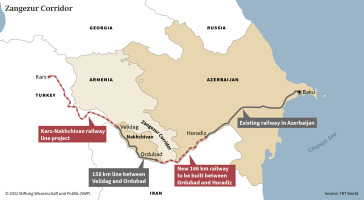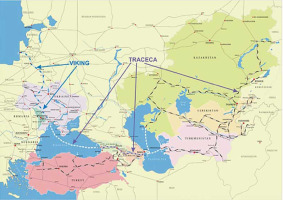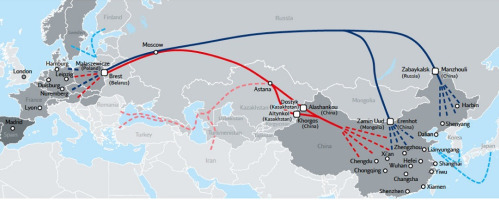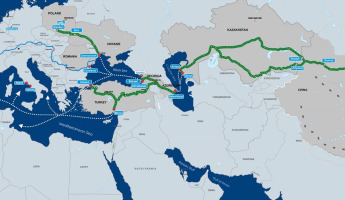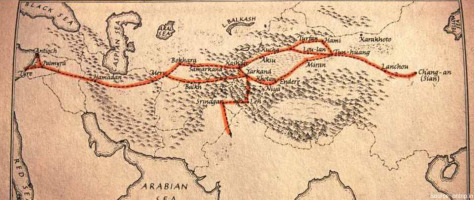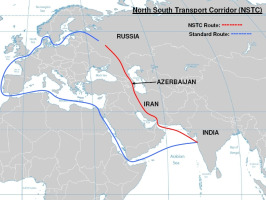Introduction
The political social and economic repercussions of the Russia–Ukraine war, which broke out in late February 2022, have led to serious discussions taking place on the liability of different transport routes. The South Caucasus is one of the most important geostrategic regions (Iskandarov et al., 2019, pp. 7–34) and an increasingly attractive transport route between Europe and Asia, but its neighbours include three ambitious Eurasian states of Russia, Türkiye, and Iran.
Even though three republics in the South Caucasus have taken different paths since the collapse of the Soviet Union in terms of policy pursued, their destinies are inextricably linked with each other, and it is impossible to assess the emerging security threats without taking the current state of affairs into account (Sadiyev and Iskandarov, 2018, pp. 47–53). The current and potential transport corridors passing through the broader South Caucasus—Caspian region generate greater economic profits for a variety of countries. The transport route that starts from China and passes through Central Asia, the Caspian Sea, the South Caucasus, and Türkiye extending to Europe is one of the shortest and the most secure and reliable routes connecting East and West (Iskandarov et al., 2020, pp. 7–22).
There is now a golden opportunity to make this route even shorter and more secure by establishing a new corridor through Armenia—the Zangezur corridor. Having considered the potential of this route, it is possible to strengthen economic and trade relationships between the countries located in this vast geographical area and to give additional impetus to the development of the region as a whole.
In this regard, Azerbaijan’s active role in creating the East–West corridor and increasing its functionality is greatly appreciated by partner countries. Azerbaijan implements an active policy of cooperation in multiple formats in order to increase the functionality of this transport corridor. There are various studies justifying the importance of this route for developing global trading, although not enough substantive academic research has been dedicated to this issue—establishment of the Zangezur corridor. For instance, Blank (2022), a senior fellow at the American Institute for Foreign Policy Studies, argues that against the backdrop of the war in Ukraine, Armenia can no longer delay the construction of a critical new transport route between Europe and Asia—the Zangezur corridor. According to De Waal (2021), a senior fellow with Carnegie Europe, specialising in Eastern Europe and the Caucasus region, the outcome of the second Karabakh war has also opened up prospects for new trade relations and economic cooperation in the region for the first time in a generation (De Waal, 2021).
Although there are different approaches and theories (e.g., realism, constructivism, Marxism, liberalism/idealism, etc.) to studying international relations and giving meaning to ongoing events and processes, this research paper is written based on the theory of neoclassical realism. The theory of neoclassical realism allows the foreign policy strategy of states to be explained by referring to issues at both international and national levels (especially in terms of explaining and predicting the choice of foreign policy course). The aim of the paper is to underscore the importance of the South Caucasus region as a conduit between West and East and justify the establishment of the Zangezur corridor as part of the global transit route. This paper includes both qualitative and quantitative review of different studies that highlight the economic and political benefits of the Zangezur corridor. In order to conduct an objective assessment, we have given preference to the opinions and the political and economic forecasts of various experts, mostly from Azerbaijan and Türkiye, since opponents of the Zangezur corridor, the so-called skeptical experts, claim that only these countries will benefit from the new transit route.
Regional state of affairs against the backdrop of great power rivalry
After the collapse of the Soviet Union, the subsequent formation of new independent states brought the South Caucasus region once again to the forefront of global power competition. The South Caucasus is now a diverse geopolitical region that plays a crucial role in the transportation of Caspian resources (Sadiyev et al., 2021, pp. 282–294). However, the region has faced several protracted conflicts emanating from the collapse of the communist regime. Even though Azerbaijan managed to liberate its occupied territories, the potential threats to its national security remain. In late September 2020, the counter-offensive operation launched by Azerbaijan ended up with the termination of the decades long so-called “Nagorno-Karabakh conflict” and restoration of Azerbaijan’s territorial integrity (Iskandarov and Gawliczek, 2021a, pp. 30–40). This war highlighted the political will of the Azerbaijani leadership and its military capacity. Azerbaijan beat an opponent whowas supported by regional and non-regional actors (Iskandarov and Gawliczek, 2021b, pp. 91–99).
Georgia could follow Azerbaijan’s lead, but there is no guarantee that it might be successful, since Russia is apparently supporting the breakaway regions. Though none of these countries is part of a West-led organisation (i.e., North Atlantic Treaty Organization [NATO] and the European Union [EU]), the state of affairs in the South Caucasus is largely influenced by the relationship between the West and Russia. Russia did not give up the region even at the very beginning of its independence when it was struggling to recover from economic and military collapse. For the last two decades, Moscow has fared pretty well by filling the void left by the West. It should also be mentioned that Russia is not alone in being interested in the region.
Another regional actor is Iran, which has concerns about its biggest Azerbaijani minority and does not hide its jealousy towards an independent Azerbaijan. Even though Iran has not articulated its intentions against the territorial integrity of Azerbaijan, it has been a staunch supporter of Armenia. For the first time in the last couple of centuries, Iran and Russia share common interests in the South Caucasus region which have developed into a strategic partnership. Iran is also inclined to prevent the presence of Türkiye in the region by referring to it as a linchpin of NATO.
Türkiye, an influential actor in both Central Asia and the Caucasus, is the driving force behind most of the regional cooperation projects. The initiation of strategic projects such as the Baku-Tbilisi-Ceyhan (BTC) crude oil and Baku-Tbilisi-Erzurum (BTE) natural gas pipelines, the Baku-Tbilisi-Kars (BTK) railway, the Trans-Anatolian Pipeline (TANAP), and its follow-up the Trans-Adriatic Pipeline (TAP) are the milestones of this cooperation (Iskandarov and Gawliczek, 2020, pp. 25–33). These projects are indispensable in terms of the diversification of routes and decreasing dependence on Russia. Armenia has always had the chance to be a part of these projects, but missed out on every opportunity by focusing more on confrontation rather than cooperation.
Of course, other actors play a crucial role in shaping events in the South Caucasus, often not by meeting their own policy objectives but by blocking the policies of other actors. For instance, the United States wants to see the whole South Caucasus as a Western-oriented region (while Russia prefers the “divide and rule” principle). The EU, as the major investor in the region, has always expressed its intention to promote stability and development. However, it lacks a hard security component to counterbalance Russia’s hard security influence. The EU’s soft power has little bearing on how different issues are settled in the region. The United Kingdom has been the largest foreign investor in Caspian oil and gas. Apart from pipelines, the United Kingdom is also a major investor in civil society’s long-term peace strategies in the South Caucasus.
Consequently, the West (including Türkiye) tries to ensure the flow of resources of the South Caucasus and the Central Asia to Europe bypassing Russia and Iran to reduce the influence of Moscow and Beijing and to keep emerging security threats to the minimum level possible (Nasirov et al., 2017). On the other hand, Russia and Iran (for the time being) prefer to exert leverage on particular nations to promote their national interests by excluding the presence of any western country in the region.
This is the current state of affairs and the situation in relation to different main actors (of course not delineated) interested in the region. At this point, it would be useful to touch upon some economy-related figures to comprehend the leverage of foreign actors on particular nations in the South Caucasus region. It should also be acknowledged that economic coercion has long been used as a tool of hybrid warfare in the region by external actors. The lack of unity in the region makes all countries susceptible to external interference.
Russian influence in this regard is more prevalent. We try to substantiate this argument with conclusive facts. For instance, because of the Russia-Georgia war, the share of Georgian exports to Russia in Georgia’s total export volume dropped from 17.8% in 2005 to 2.0% in 2008. Simultaneously, the share of Russian imports to Georgia dropped from 15.4% in 2005 to 6.7% in 2008 (Iskandarov and Gawliczek, 2022, pp. 47–57). Russia is the main source of financial income for a large number of people from all three countries. Remittances from Russia to Azerbaijan amounted to over US$1.133 billion, while Georgia in 2021 earned about US$1.3 billion from exports to and remittances and tourist inflow from Russia. The volume of transfers of individuals from abroad to Armenia amounted to US$1.898 billion in January–November 2021, of which US$781 million went to Russia (Iskandarov and Gawliczek, 2022, pp. 47–57). In the next paragraph, we highlight the advantages of the Zangezur corridor for boosting the economy of the stake-holders and reducing external dependence.
Zangezur corridor in the offing: challenges and prospects
After 30 years of confrontation, there is hope of peace between Armenia and Azerbaijan, which is a sine quo non for regional prosperity and security. However, there are still foreign actors who want to sabotage and prevent it. It is clear-cut fact that the destiny of Armenia is discussed at tables where Armenia itself is not seated. Otherwise, it is not difficult to anticipate or predict the dividends the prospective peace treaty might bring to Armenia. For instance, one of the most commonly discussed topics after the second Karabakh war is the Zangezur corridor, which promises wider economic benefits for both Armenia and Azerbaijan. At this point, it would be useful to estimate the volume of the loss inflicted on these two countries because of the conflict that had lasted for almost 27 years. In fact, it is really difficult to present the exact figures, although numbers are undeniably high. Having analysed multiple dimensions, Saha et al. (2018) introduced the following table 2 years before the second Karabakh war to illustrate the effects of the conflict (Table 1).
Table 1
The estimated impact of Armenia-Azerbaijani conflict on the parties (Saha et al., 2018).
Having included the amount of money spent on the second Karabakh war in 2020, the second dimension of fiscal would remarkably swell. Then, who gained an advantage from this conflict? Of course, other actors capitalised on it and tried to fill the gaps left by the confrontation between Armenia and Azerbaijan.
The opening of the Zangezur corridor (Figure 1; Eldem, 2022) will change the transit map of the entire region. The land connection between Azerbaijan and Türkiye will be ensured, and a railway line will be built between Armenia and Russia through Azerbaijan. In other words, the Zangezur corridor will connect both Azerbaijan and Türkiye as well as Armenia and Russia. In addition, for the first time in modern history, Russia and Türkiye will have a railway connection.
Anastasia Lavrina justifies the importance of the Zangezur corridor at the global level:
The Zangezur corridor will become the shortest land transport route between the Pacific and Atlantic oceans, as well as the intersection point of the North–South and East–West routes. It will significantly expand the operation of land transport routes connecting Europe and Asia (Aze.Media, 2022).
According to Blank (2022), this is the missing link in one of the only East–West trade routes that can bypass Russia. If Armenia is really a friend of the West, as its large diaspora claims, it must return to the negotiating table and immediately allow the opening of the corridor.
If we consider the map of the Caspian-Black Sea region on a larger scale, we see that the most ideal route to the Far East, as well as to the West, passes through the Türkiye– South Caucasus–Caspian region. To make these routes operational, the participation of Azerbaijan in particular is a must. There are several options for the network of routes passing through Azerbaijan to reach Türkiye and then Europe: Georgia, Armenia, and Iran. Although the most profitable transit country in terms of distance is Armenia, the long-term conflict between Erevan and Baku has caused it to be left out of all projects. This gap has been filled by Georgia and Iran from time to time. Undoubtedly, the creation of a new corridor will significantly reduce the importance of these routes. It should be noted that among some media agents of Iran, it is claimed that with the opening of this corridor, Tehran will face the following risks:
Azerbaijan used to pay 15 percent of the 350 million cubic metres of gas sent to Nakhchivan through Iran as a transit fee. With the opening of the new corridor, Iran may lose this profit.
An agreement on sale of gas was signed between Türkiye and Iran in 1996. Based on that agreement, Türkiye has been buying gas from Iran for years. While Türkiye pays Iran US$490 for a thousand cubic metres of gas, it can buy the same amount from Azerbaijan for US$335.
If a gas pipeline is built from Azerbaijan to Türkiye through this corridor, Iran’s loss of gas revenue may be huge.
The planned gas pipeline project from Turkmenistan through Iran to Türkiye then to Europe was frozen in 2017 because of financial disagreements. Turkmenistan can now deliver this gas to Europe via Azerbaijan.
The importance of Iran’s pipeline to Armenia has also decreased.
The US-backed trans-Caspian pipeline project may come up again. This pipeline, which will extend from Turkmenbashi, the capital of Turkmenistan, to Azerbaijan, may be merged with the existing pipelines passing through Azerbaijan, Georgia, and Türkiye (Piriyev et al., 2022).
In addition, since the trade route from Türkiye to Central Asia passes through Iran, this route will also lose its importance with the opening of the new corridor. According to the opinions of businessmen and political figures of Eastern Anadolu, the current export capacity of US$160 million in Erzurum, Kars, Ardahan, Aghrı, and Ighdir through this corridor will increase by 3.1 times to up to US$500 million. The Strategic Council of Foreign Relations in Tehran, whose director is Iran’s former minister of foreign affairs Kamal Kharazi, condemned the construction of the Zangezur corridor, indicating that the corridor has been introduced as NATO’s “Turan corridor,” a project ostensibly supported by Israel and NATO, which aims to foment ethnic unrest in the areas of Iran inhabited by Turks. As per the aforementioned Council, NATO’s Turan corridor is supposed to directly bring NATO onto the northern border of Iran, the southern border of Russia, and western China and lay the groundwork for their disintegration (Shokri, 2022).
We tried to find research studies (in English, Russian, Azerbaijani, and Armenian) which justify the “disadvantages” of the Zangezur corridor for Armenia and its citizens. However, there is not even a single substantive study that highlights these “disadvantages,” except for several rhetorical statements we have come across in different sources. Even Armenian researchers try to underscore the drawbacks of this corridor primarily for Iran, which in turn raises doubts about the manipulation of the politico- academic elite of this country. For instance, an Armenian expert in Iranian studies, Emma Baghijanyan, states that Iran is pretty much concerned with the opening of Zangezur corridor, and unfortunately it claims that its interests coincide with Iran’s (Stepanyan, 2022). Why unfortunately? Because even though there are a number of studies highlighting the disadvantages for Iran of the new corridor passing through Armenia, as we have mentioned there is not any single conclusive study presenting the downside for Armenia. Another expert in Iranian studies, Aharon Vardanyan, also highlights Iran’s negative stance regarding the Zangezur corridor rather than Armenia’s reluctance (Martirosyan, 2021). By referring to President Ilham Aliyev’s statement on Iran’s opposition to the project, some experts, such as Mirzoyan (2022), try to set Baku and Tehran against each other over the Zangezur corridor, rather than focusing on the relations between Yerevan and Baku. Political analyst, Areg Kochinyan, argues that “Armenia is categorically against the word ‘corridor’, which is not in the document and which, to them, implies a loss of sovereignty over this territory” (JAM-News, 2022). Therefore, we introduce the following excerpt from the tripartite agreement (Article 9) retrieved from Armenian sources:
All economic and transport links in the region shall be unblocked. The Republic of Armenia shall guarantee the safety of transport communication between the western regions of the Republic of Azerbaijan and the Nakhichevan Autonomous Republic with a view to organize the unimpeded movement of citizens, vehicles and cargo in both directions. Control over transport communication shall be exercised by the Border Guard Service bodies of the FSS of Russia (The Office to the Prime Minister of the Republic of Armenia, 2020).
If the word “corridor” is not acceptable by Armenia, it might be called anything, since the content is the same, which ensures unobstructed movement of people, vehicles, and cargo in both directions. According to Armenia, the term “corridor” implies the extra territoriality. However, President Ilham Aliyev stated that checkpoints should be established at both ends of the Zangezur corridor (Press Service of the President of the Republic of Azerbaijan, 2023), which in turn excludes the option of extra territoriality and dispels the doubts about any threats to Armenian territorial integrity. Kucera (2023) states that for Baku, the promise of the corridor and the geopolitical advantages it would bring helped convince it to stop its offensive in the 2020 war and accept the presence of Russian peacekeepers onthe territory. Kochinyan claims that “corridor logic” is in the interest of Russia and with the creation of the corridor, Russia would have the opportunity to control the border of Armenia. A gentle reminder for some Armenian analysts is contained in Kochinyan’s statement. This is not something new, Armenian borders have been controlled by Russia for decades. At the same time, Kochinyan states that, “The peace agreement and resolution of the conflict are unfavourable to Russia. It needs the status quo, the endless war between Armenia and Azerbaijan and the peace process—for the sake of the process, not a solution” (JAM-News, 2022). Even some experts, such as Stepan Danielyan (Panorama.am, 2022), blame France for hindering this project by stating: “The age-old French-English rivalry was particularly intensified after Britain left the EU, and now France wants to strike back at Britain, preventing the delivery of Azerbaijani energy to Europe.” In March 2021, the Prime Minister of Armenia, Nikol Pashinyan, acknowledged the importance of unblocking communications by saying:
The unblocking of communications is profitable for Azerbaijan, because it will thereby get a communication link with Nakhchivan and it is profitable for Armenia, because we must have a reliable railway and overland communication with the Russian Federation and the Islamic Republic of Iran. This means that the economy of our country can change significantly (De Waal, 2021, p. 4).
Raffi Mkhjan, the head of the Armenian Exporters Union, stated that the opening of Armenia–Azerbaijani routes would turn the country into a “Gateway to the Caucasus” (De Waal, 2021). The bottom line is that the opening of the Zangezur corridor will be beneficial for Armenia. The fact that the borders with Türkiye and Azerbaijan were closed did not allow Armenia to get a safe and sustainable land route to its main economic partner, Russia. After the beginning of the Armenian–Azerbaijani conflict, the railway that enabled the movement from Armenia to Russia or in the opposite direction was blocked. The only existing land route is the road passing through the territory of Georgia, which is geographically difficult to move and is usually closed in bad weather conditions. It always causes interruptions in transportation from Armenia to Russia and vice versa. At the same time, political disagreements between Georgia and Russia led to the closure of this road in some cases. Generally speaking, the opening of the Zangezur corridor chime with the policy of the Armenian government, which seeks ways to eliminate or at least reduce its dependence. It is just being cautious in this matter, fearing that there will be a backlash against the government. Opinions voiced against the opening of the corridor are mainly put forward by Armenian nationalists, which are supported by foreign actors (more precisely, some circles in Iran, Russia, and France). It has also become a tool for the opposition to influence the current government. Therefore, as soon as the political situation stabilises and the benefits of opening the corridor are perceived, Armenians will come to terms with it. Therefore, if the political statements are not followed by practical activities, it casts serious doubts on the Armenian national and political will, rendering Yerevan susceptible to foreign interference. Having highlighted Armenia’s inclination to issue provocations to slow down the opening of the Zangezur corridor, the Russian expert, Yevgeny Mikhailov, insinuates that this is Yerevan’s dependence on a foreign actor and argues that it won’t refuse to participate in such a promising project for the benefit of the country’s economy (Report News Agency, 2021). There is now a golden opportunity to strike a peace deal to end the decades long confrontation. That is what Armenians should think of, not sabotaging the Zangezur corridor through playing with words. The good thing in Kochinyan’s statement is that time is against Armenia, and “any concession that was possible yesterday is no longer possible today” (JAM-News, 2022), because the restoration of communications is important for Armenia, which has been suffering from an economic blockade for the last three decades. David Hovhannisyan, the former Armenian diplomat, and the director of the Arabic studies department at Yerevan State University, states the following: “The Iranian government is using Armenia as a point of contact with the outside world, senior regime figures go to Armenia to get a rare respite from the strictures of their own government, and they turn a blind eye to other well-connected Iranians doing the same” (Gavin, 2022). It means Iran is concerned that they might be deprived of this entertainment in case [the] Zangezur corridor is established, which is a pretty ridiculous justification. According to Zohrab Mnatsakanyan, Former Minister of Foreign Affairs of Armenia, “As tensions remain unresolved in the region, the convergence of interests of Armenia and Iran under these circumstances most ostensibly concerns the security of their common border” (Gavin, 2022).
Hussein Banai, an associate professor at Indiana University, warns that the international community should be worried about Tehran taking advantage of Yerevan’s vulnerability to strengthen its hand. “The West should be worried about the prospect of Iranian influence growing in Armenia—or anywhere,” he said (Gavin, 2022). All these facts prove that Armenia is pretty vulnerable to foreign meddling.
Türkiye is able to provide the freight transportation route for southeast European countries (Bulgaria, Greece, and Romania), especially the Transport Corridor Europe-Caucasus-Asia (TRACECA; Figure 2) (GUAM, 2017). The TRACECA programme proposed by the EU in 1993 envisages connecting Europe to Central Asia through transport corridors passing through the Black Sea, the South Caucasus, and the Caspian Sea.
The volume of goods exchanged between China and the EU is measured in trillions of dollars. At present, goods from China pass through Central Asia, are loaded onto ships, and transported across the Caspian Sea to the port of Alat. The goods are then transported to Türkiye on the Baku–Tbilisi–Kars railway, and from there to Europe. This process takes 2 weeks. Of course, European goods are also sent to China in the opposite direction. As we have mentioned above, the Zangezur corridor is the shortest route connecting the EU with China. In addition, Blank (2022) states that this route is more reliable than the one passing through the Georgian territory, with regard to the relations between Moscow and Tbilisi. The expert highlights that in the midst of Russia’s blockade of global supply routes, there are few viable solutions for transporting goods from East to West, and the Zangezur corridor stands out as the most optimal among them.
The idea of a land route from China to Europe was one of the issues on the agenda after the fall of the Soviet Union. Initially, the opening of the route was blocked due to bureaucratic obstacles and complicated border procedures. Later, the emergence of China as a major economic power gave impetus to the process. In 2015, approximately US$423 billion of China’s US$2.37 trillion exports was sent to Europe, and US$12.1 billion was sent to Central Asian countries (Kazakhstan, Kyrgyzstan, Uzbekistan, Turkmenistan, and Tajikistan), which underlines the importance of the trans-Eurasian corridor for China (Figure 3; Von Witte, n.d.).
The northern route through Russia (bypassing Central Asia) is about 13,000-km long (Figure 2), with a total route time of about 16 days. Therefore, as it is obvious from the picture, the shortest route connecting China to Europe passes through the territories of Kazakhstan, Uzbekistan, Turkmenistan, the Caspian Sea, Azerbaijan, Armenia, and Türkiye, shortening the total distance by at least 3,000 km and, most importantly, reducing Russia’s influence on Europe. This once again proves the importance of opening the land route through the territory of Armenia to Nakhchivan.
Apart from this, China’s “one belt, one road” initiative (Figure 4) is of great importance for the South Caucasus region in terms of realising the potential of the region in the field of transit transportation. Azerbaijan is one of the first countries to support this project. Azerbaijan plays an important role in the transportation of goods from China to Europe and vice versa, and the trans-Caspian international transport route passing through Azerbaijan is compatible with China’s “one belt, one road” initiative, and the Chinese side shows great interest in this corridor in terms of container transportation. Even though, in theory, the easiest route is through Iran, the ongoing sanctions and obvious reluctance to invest in Iranian railways undermine the reliability of this option (Blank, 2022; Desierto, 2017).
Figure 4
“One Belt, One Road” initiative (retrieved from source: https://theonebrief.com/chinas-global-ambition-balancing-opportunities-and-risks-in-one-belt-one-road/).
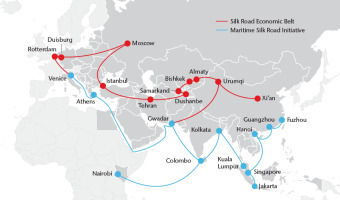
The Zangezur corridor is also compatible with the EU’s “TRACECA” (Figure 2) and Türkiye’s “Middle corridor” (Figure 5; Papatolios, 2022) projects to connect China to Europe.
The Middle corridor is a rail freight and ferry system that starts from China, passing through Kazakhstan (Turkmenistan can also offer its territory), the Caspian Sea, the South Caucasus (Azerbaijan and Georgia), and Türkiye and extends to the EU countries. This is the project preferred by the Turkish government. It is a priority for the South Caucasus countries (Armenia has a chance to be part of this project as well). In fact, geographically, this is the shortest route between western China and Europe (Carafano, 2022).
As mentioned previously, if the Zangezur corridor is used, the new route would be even shorter. For this purpose, Türkiye signed a memorandum of understanding (MoU) with China in 2015 to establish a link between the “Middle corridor” initiative and the “one belt one road” initiative. Türkiye is able to access export markets and become a logistics hub for EU–China trade while dealing with regional instability issues in the eastern regions. Türkiye’s support for the resolution of the Nagorno–Karabakh conflict is also an element of this policy. Türkiye is considered a reliable trade partner for Central Asian countries.
According to the report entitled “Observation of Economic Complexity” (OEC), Türkiye’s trade turnover (import and export) with Kazakhstan was US$2.35 billion in 2017, with Uzbekistan US$1.49 billion, with Turkmenistan US$1.4 billion, with Tajikistan US$351 million, and with Kyrgyzstan US$442 million. In 2019, Türkiye’s total trade turnover with Central Asian countries was about US$8.5 billion. The main reason for Türkiye’s preference for this project is to increase its trade turnover with the countries of the South Caucasus and Central Asia as well as with China. In this regard, the southern route through Iran is no longer considered favourable. Turkish-owned trucks travelling along the “southern corridor” are thus subject to delays caused by long queues at the Gurbulak customs post (the Iran–Türkiye crossing point) and suffer from fuel taxes imposed by Iranian officials. However, some researchers point to the political tension between the two countries as a serious obstacle to trade. It should also be mentioned that the Middle corridor does not hold the capacity to meet all the demands regarding the volume of trade and to replace the routes passing through Russia (currently, it has only about 5% of the Russian route’s capacity). However, it is a really invaluable project as far as the diversification of routes is concerned, since China–EU shipments along the northern corridor have decreased by 40 percent since Russia’s invasion of Ukraine (Eldem, 2022).
It should be highlighted that Central Asian countries have been spending heavily to develop modern infrastructure. For instance, Kazakhstan invested approximately US$35 billion over the last 15 years to build more than 2,000 km of railways, 19,500 km of roads, 15 airports, and port capacities along the Caspian Sea. In 2022, Kazakhstan announced a US$20 billion investment package for diversifying transit and freight transport routes and integrating logistics solutions (Carafano, 2022).
The Old Silk Road or China–Central Asia–Europe corridor through Central Asia (Figure 6; Choong, 2017), Iran, and Türkiye to Europe is another alternative to the northern options. However, because of the tensions with Iran and ongoing instability in Syria, the reliability of this route is not high and investments are not encouraged.
It should also be mentioned that Azerbaijan joined the International North–South transport corridor (Figure 7; Insights on India, n.d.) in 2005. The purpose of initiating this project was to reduce the delivery period of freight from India to Russia as well as to northern and western Europe (the delivery period on the current route is more than 6 weeks; it is expected to be 3 weeks via North–South transport corridor). Once the Zangezur corridor is available, it will be possible for Armenia to benefit from the North– South transport corridor.
Meanwhile, some experts argue that Armenia can be a part of this project (the second leg: Iran–Armenia–Georgia–Black Sea) by offering its territory. Poghosyan (2021), the chairman of the Center for Political and Economic Strategic Studies in Yerevan, justifies the improbability of this idea in the following way:
The existing Armenia–Iran international M2 highway passes through mountainous areas and is prone to disruptions, especially during winter time. Current and potential roads may satisfy local Armenian demand and serve the Iran–Armenia transit, but it can definitely not be perceived as a viable route for international transit.
Poghosyan (2021) himself admits that in relation to the North–South transport corridor, Azerbaijan constructed a railway which goes up to the Iranian border town of Astara, and Iran completed the construction of the Qazvin–Rasht section. The only missing part is the Rasht–Astara section, which is approximately 150 km (Figure 8). As Poghosyan mentioned, it would be better to be realistic and Armenia should not lose an opportunity to benefit from this corridor and abstain from any wishful thinking.
Figure 8
Astara–Rasht–Qazvin railway (retrieved from source: https://www.railfreight.com/corridors/2022/08/25/iran-a-corridor-and-a-missing-link-will-russia-unlock-them/).
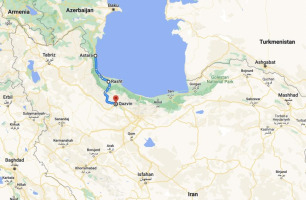
Considering all these factors into account, we deduce the following three possible scenarios regarding the opening of the Zangezur corridor, and each of these scenarios has a different implication on the security architecture of the overall region:
Scenario 1. The opening of the Zangezur corridor will be achieved as soon as all necessary infrastructure is completed. This is the option preferred by Azerbaijan and is the most realistic one, even though it may damage the reputation of the current Armenian government.
Scenario 2. The opening of the Zangezur corridor will be achieved as soon as the opposing group in Armenia (which is apparently supported by foreign actors) is counterbalanced by the vast majority of Armenians who are interested in the prosperity of their country. For the time being, this tendency is increasing and there is progress, but not enough. In fact, this is an option embraced by the Armenian government. It is apparent that the leadership is trying to gain time, since it is not easy for a country like Armenia to shake off the tentacles of foreign actors (both state and non-state) with their strong leverage on Armenia.
Scenario 3. Armenia rejects the opening of the Zangezur corridor. This is the least plausible option since the tripartite agreement of 10 November 2020 explicitly dictates the opening of communications. This option will definitely undermine the prospects of long-lasting peace in the region and spur Azerbaijan into military action, which is not desirable for any party. Only the foreign actors will benefit from the renewed conflagration—actors who have gained the upper hand over the Armenian economy, society, and security.
The analysis shows that there is a conventional wisdom in Armenia that whatever Azerbaijan wants to be implemented should be prevented by Armenia and its global supporters, whether it is in the Armenians interests or not. This makes research like this necessary for enlightening the Armenians at large. It will simultaneously help them not to fall victim to the games of different actors in the region. As a result, the most plausible scenarios (i.e., Scenarios 1 and 2) regarding the Zangezur corridor, which anticipate the success of this important project, serve the same objective, maybe with different time frames. In this regard, the opening of the Zangezur corridor will be a stepping stone towards long-lasting peace in the region.
Conclusions
All the countries of the region can therefore benefit from the opportunities arising from the opening of the Zangezur corridor, which will serve to expand regional cooperation and increase mutual trust. With the opening of the Zangezur corridor, a new “artery” of the transport network between Europe and Asia will be established. This will ultimately have a positive effect on economic and trade relations between West and East as well as among the countries of the region. Armenia can enjoy the advantages of the Zangezur corridor; in other words, if it attaches importance to regional cooperation, it may experience positive indicators in socioeconomic fields. First of all, it will get an opportunity to emerge from economic isolation and undergo economic development. Otherwise, it will lose a clear opportunity to improve and integrate its overall economy. Therefore, the Zangezur corridor is a major project which has a true potential to contibute to the establishment of long-lasting peace to end decades of long enmity.


